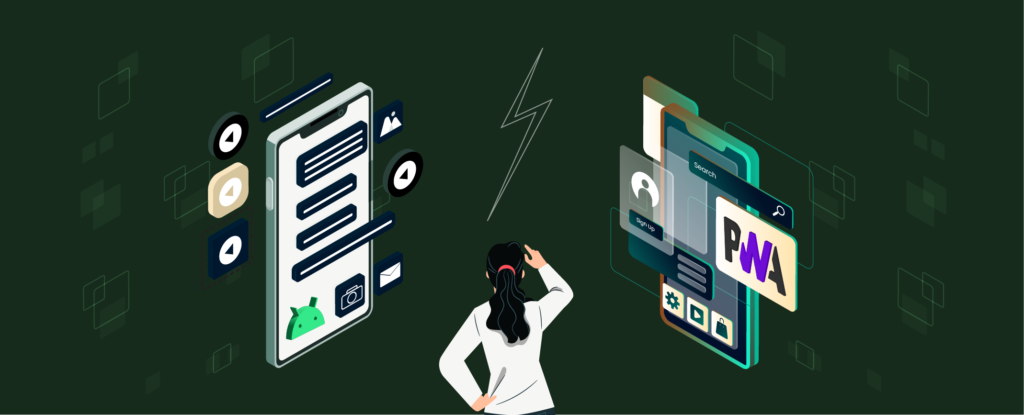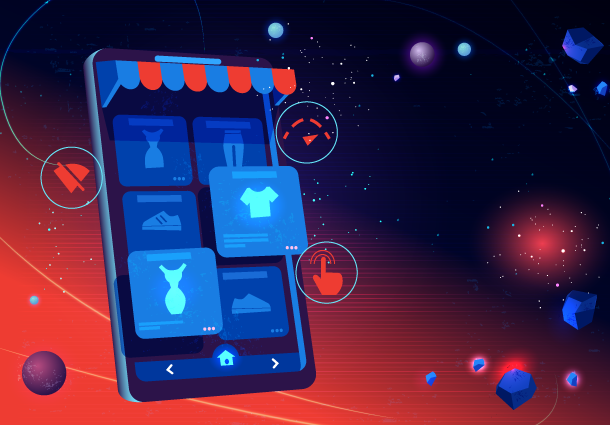Ontological Inquiry into the Essence of Native Apps and the Evolutionary Elegance of Progressive Web Apps
While starting an app development journey, there are two choices to consider: Native apps and Progressive Web Apps (PWAs). Make the proper decision at this crossing point. This examination uncovers the logical inconsistency of native vs progressive web apps, where development and tradition come together in a fluid dance of usefulness. Consider your application as the primary person who is positioned between two particular storylines, every one of which guarantees a thrilling excursion. The carefully prepared contenders in this story, native apps, utilize the force of platform-specific capacities to give a redid experience to each operating system. They have profound roots and utilize the built-in features of gadgets. Progressive Web Apps, then again, become the digital travelers of the scene. They are versatile and adaptable, moving between gadgets effortlessly and muddling the differentiations between the web and applications. The account extends as we analyze the difference between native apps and progressive web apps, figuring out how accessibility, performance, and user experience assume critical parts in this development story.
moving between gadgets effortlessly and muddling the differentiations between the web and applications. The account extends as we analyze the difference between native apps and progressive web apps, figuring out how accessibility, performance, and user experience assume critical parts in this development story.
Join us on this excursion of revelation as we investigate progressive web apps vs native universes, uncovering the nuances that decide your application’s future. In this examination, choices become personas, and the course of development turns into an immersing story with high stakes and a coded goal. Selecting between Native and PWAs turns out to be more than basically a specialized choice; it’s likewise an essential excursion with huge ramifications for your application’s future on the digital landscape.
A Semiotic Analysis of the Symbiotic Relationship Between Web and App
The internet’s demigods, Progressive Web Apps (PWAs), are changing the way that we interact with the web. Envision a website that gives a consistent and engaging client experience, loads rapidly, and has capabilities like a different application. PWAs are mystical in that way. PWAs are intended to be dynamic and responsive, acclimating to the client’s device and network conditions, as opposed to conventional website pages. They bring the most ideal scenario, consistently overcoming any issues between web and native applications. Imagine a high-energy show where the website runs effortlessly on all devices, including PCs and cell phones.
PWAs address the radicals against the current status of application stores. They free clients from the limitations of traditional application establishments, empowering fast access without the burden of downloads. It’s like not having to wait in line for VIP access to your favorite material. The super trademark that separates PWAs is their offline functionality. They keep a consistent experience even in case of an unsatisfactory internet connection by caching fundamental assets. It is similar to an unbroken encore act, consistently poised to amaze. PWAs are capturing everyone’s attention in a world where quick fulfillment, smooth communications, and speed mean the world. They are the heroes of the web. Welcome to the Progressive Era and bid adieu to sluggish websites.
Dissecting the Unmatched Fidelity of Native Mobile Applications
A software application made particularly for a specific platform or device and utilizing the native programming languages and frameworks presented by that platform is alluded to as a native app. Native apps are made to completely use the unique elements and capacities of a specific working framework, offering a smooth and ideal client experience, rather than web applications, which run through web browsers. Languages like Java or Kotlin for Android, Swift for iOS, and C# Windows are generally used to compose native apps.  Platform-specific languages empower developers to completely use the abilities of the basic software and hardware, prompting further developed responsiveness, faster performance, and smoother animations.
Platform-specific languages empower developers to completely use the abilities of the basic software and hardware, prompting further developed responsiveness, faster performance, and smoother animations.
The capacity of native apps to easily communicate with the hardware and built-in features of the device, like cameras, sensors, and push notifications, is one of its principal benefits. Deep integration ensures a captivating client experience and allows developers to design apps that are in a split second conspicuous to platform clients. The upsides of native app development over cross-platform choices as far as execution, client experience, and platform-specific elements make them the go-to choice for some developers who need to make top-quality software that is modified for a specific operating system, even though native app development might include more work and resources.
A Sagacious Inquiry into the Merits and Demerits of Progressive Web Apps vs. Native Mobile Applications
Two popular methods for creating mobile applications are Progressive Web Apps (PWAs) and Native Apps, each having a special set of advantages and drawbacks. Comprehending progressive web apps vs native is fundamental for organizations and developers seeking to track down the best fit for their novel prerequisites. PWAs make use of online technologies to give clients an application-like encounter through a web browser. Standard web technologies like HTML, CSS, and JavaScript are utilized in their development. PWAs’ cross-platform interoperability, which empowers them to work immaculately across various hardware and operating systems, is one of their fundamental benefits. Clients no longer need to download and update applications from an application store because PWAs are famous for their basic and rapid installation process.
Nevertheless, Native Apps are made particularly for a specific platform, similar to iOS or Android, using Kotlin/Java for Android and Swift for iOS. The client experience is commonly worked on by native apps’ more prominent execution and access to device-specific functionality. Yet, keeping particular codebases for several platforms can be costly and tedious. Since Native Applications are optimized for the specific platform and can completely use device capacities, they normally run better compared to PWAs. Regardless of whether PWAs are viable, they probably won’t be pretty much as speedy or responsive as Native Apps.
Accessibility is one more significant part of the native vs progressive web apps comparison. Native apps are typically made accessible through application stores, where they get trust and visibility from clients. PWAs, then again, are more available in certain circumstances since they can be shared through URLs and are discoverable via search engines. Between the two, updates and maintenance are additionally unique. PWAs can be updated consequently without the requirement for user input, ensuring that everybody is utilizing the latest version. Be that as it may, clients of native apps could need to update them manually through application stores. The choice of PWA vs native app is impacted by various factors, including the target audience, development resources, and performance needs. Organizations need to think about these viewpoints completely to conclude which method is best for their mobile app development plan.
Pondering the Prowess of Progressive Web Apps Against the Native App Citadel
There are two distinct ways of designing mobile applications: native apps and progressive web apps (PWAs). Each has pros and drawbacks of its own. The choice you make PWA vs native app, will depend on various factors, like the necessities of your undertaking, the target group, and development needs. PWAs are web applications that use contemporary web technologies to offer a cross-platform native app-like experience. Since they can be accessed through internet browsers, they are easier to oversee and are free of platforms. PWAs have benefits including cross-platform interoperability, offline functioning, and seamless updates. When contrasted with native applications, they can be more reasonable to design and typically deploy all the more rapidly. PWAs may, be that as it may, run less well than native applications and do not have the option to access all device functionalities.
On the other hand, Native Applications are made particularly for a specific platform, similar to Android or iOS. They have total access to the device’s functionalities and are developed using platform-specific languages (Kotlin or Java for Android, Swift or Objective-C for iOS),  which prompts brilliant execution and a rich client experience. Moreover, native applications can profit from platform-specific design standards, which ensure a smooth change in the appearance and feel of the operating system. Then again, creating and overseeing particular codebases for several platforms could require a lot of time and resources.
which prompts brilliant execution and a rich client experience. Moreover, native applications can profit from platform-specific design standards, which ensure a smooth change in the appearance and feel of the operating system. Then again, creating and overseeing particular codebases for several platforms could require a lot of time and resources.
The goal of the project is to figure out which option— native vs progressive web apps —to use. A PWA can be the most ideal decision if reaching an enormous crowd and giving a predictable encounter across numerous platforms are the first concerns. PWAs are particularly useful for e-commerce, content-driven apps, and services where cross-platform accessibility is fundamental. In any case, a Native Application is presumably an ideal choice if the goal is to give a profoundly modified, feature-rich experience in the most ideal performance. The secret is to understand the difference between a native app and a progressive web app and coordinate the selected strategy with the unique requirements of the program and the user base’s expectations.
Envisioning PWA Development Services through the Prism of Digital Patterns
Our Progressive Web App development company is a commendable illustration of how to consolidate creativity and sophistication consistently. We set off to make unequaled digital encounters, with each PWA carefully created to stretch the boundaries of client commitment. Our inventive methodology, which uses best-in-class web technologies to make PWAs that outperform expectations, mirrors our dedication to quality. Our staff of creative specialists and designers, skilled at transforming concepts into engaging and versatile online applications, is the underpinning of our capacities. We go beyond the standard, putting user-centered design, maximized execution, and smooth cross-platform operation first. With an unfaltering obligation to excellence, we ensure that each PWA we produce is a show-stopper that impeccably combines style and functionality. Choose us for an extraordinary excursion into the domain of Progressive Web App development, where brilliance meets custom arrangements.





